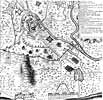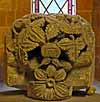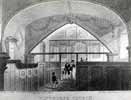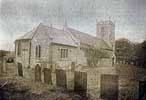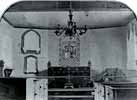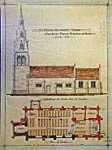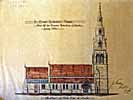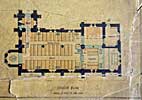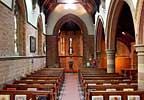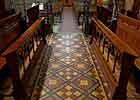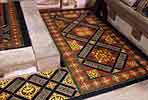For this church:    |
Winthorpe All SaintsArchaeologyPrevious churches
It seems likely that the current church is the third to have been built or largely re-built on the site. The first church existed during the English Civil War and is just visible as a ruin on Richard Clampe’s Siege Plan of Newark, 1645-6. The consecration leaflet of 1888 states: 'The old church was evidently knocked down during that trying and troublous period, and a redoubt formed on its site. On making excavations for the present structure the steps on which the cannon used to stand, and quantities of damaged gunpowder, were found. The skeletons of some hundreds of men were also discovered buried in rows, and evidently without any coffins.'
It is doubtful whether the church was actually knocked down, as Samuel Hieronymus Grimm’s drawing of the church in 1773 shows the south elevation of a building which has mixed elements of medieval and possibly early post-medieval, and therefore not from after the Civil War. The south doorway, for example, although drawn with extreme simplicity, may well represent a 12th century opening with hoodmould. The simple windows may be stylized lancets or they may be post-medieval, square-headed lights. This church, in 1773, possessed a tower with battlements and four pinnacles, buttressed at the junction with the nave, and with plate tracery belfry lights having two lancets, presumably on all four sides of the tower, and probably early 13th century; the battlements appear to be a late medieval addition. Two buttresses supported the south wall of typical unelaborated 13th century form. Four years later Roger Pocklington, owner of Winthorpe Hall and patron of the church, rebuilt the church in brick, apparently keeping only the original south wall relatively intact, although some existing features were incorporated into the new design. The tower was rebuilt and raised, with the three bells being housed in the new higher section, the whole being finished off with Palladian urns and balustrades. Just below the new belfry level, on the north side of the tower, was placed an oval stone tablet which reads: 
This tablet now lies in the churchyard. A north porch was added, and the south door was blocked off to create a fireplace with a tall external chimney, although the hoodmould over the south door was retained. A new chancel was built and a similar fireplace and chimney added on its south wall. At the apex of the chancel arch was placed a stone boss, Strawberry Hill Gothic in style (Gothic revival), which is dated 1778, and is now sitting in the current porch. It is visible in the J. D. Curtis drawing of the church interior in 1823. Pinnacles similar to those on the old church tower were placed on the gable between the chancel and the nave. One of these survives in the churchyard today. The windows in the chancel and those in the new belfry stage of the tower were similar in style to those in the old tower. A vestry was built on to the north side of the chancel, its windows mimicking those on the retained south wall of the old church, and also those in the tower. There is a door lock and key which is dated 1777, and, according to the current church inventory and terrier, is from the vestry door of Pocklington’s church. There are a few surviving drawings and photographs of the Pocklington church, which was unaltered until the current church was built in 1886-8. The earliest of these is by Bartholomew Howlett, and shows the north side of the church as it was in 1807, although it is markedly different from later photographs (c.1880) of the same building. In particular it is missing the vestry, but given the date on the lock (described above), the statement in the terrier that the lock was from the vestry door and also the extremely good match of building materials between chancel and vestry, this is perhaps just artistic licence.
In 1880 it appears that J. W. Fowler, architect of Louth, was engaged to draw up plans for rebuilding the church, and one of his drawings shows the south elevation and plan of the church as it existed at that time. From these it is possible to calculate that the Pocklington church was approximately 79 feet long (excluding the tower) with a nave and chancel approximately 19 feet wide. The vestry added a further 11 feet to the width of the church at its east end, making a width of approximately 30 feet maximum. If the retained south wall is a good indication of the size of the church in the early 1770s and earlier, its length would have been approximately 50 feet, excluding the tower.
J. W. Fowler’s plans of 1880 for the proposed restoration of the church and the accompanying letter which he wrote to Archdeacon Brough Maltby (of Farndon) show that he still intended to retain the south wall and the walls of the tower, and the internal design and some of the exterior features are remarkably similar to the church which exists today. It is interesting to note that in his letter to the Archdeacon he states 'I have as you will see, added a north aisle, or rather have restored it, for one existed here before the present church was built.' This is the only known reference to the interior of the church which existed before Pocklington’s restoration. Despite his best efforts, Fowler’s proposals were never accepted, and all we are left with are his exquisite drawings and plans. Current churchThe Revd. Edward Handley became the patron of Winthorpe church in 1884, and its rector in 1886. According to the consecration booklet of 1888, at this time the church 'possessed no points of beauty or even of security, and threatened at any time to have fallen on the heads of the congregation. On the Rev. Edward Handley succeeding to the advowson, he determined to remove this structure, and to build an entirely new church in memory of the late Mr. Philip Handley, of Muskham Grange, who, with many members of his family, are interred in the vault beneath the vestry.'
The proposed drawings of J. W. Fowler in 1880 appear to have been discarded in favour of a new design by Sidney Gambier-Parry in 1886, an architect who had worked on the church of St Mary the Virgin, Bathwick, Bath, with which the Revd. E. Handley had several connections. He went on to use many of the craftsmen who had also worked on St. Mary’s in previous years, and whose work was most likely familiar to him. There were, however, a number of similarities between the Fowler and Parry designs and it remains to be discovered whether or not these were purely coincidental. Again from the consecration booklet: 'The new building was begun in August, 1886, and the foundation stone laid on All Saints' Day by Sir Henry Bromley, of Stoke. It is designed in the style known as Early English, or that which was in vogue in this country in the thirteenth century. The new church, though considerably larger than the building which formerly occupied the site, follows in part the lines of the church it has replaced. The nave and chancel occupy precisely the same position as those of the old, but the west tower of the old church has been replaced by a baptistry, and the new tower, north aisle, organ chamber, vestry, and east end of the chancel, occupy new ground.' When examining the plans of the old and new churches, it can be determined that the last sentence of the above is not strictly true. The nave and chancel of the new church are almost exactly the same size as the old, therefore if they do occupy the same position, the vestry of the new church, being twice as big from north to south as the vestry in the old church, actually occupies the same ground as the old vestry did, plus the same size again of new ground extending in a northerly direction. The new ground covered by the east end of the chancel would amount to one or two feet at the most. Further extracts from the consecration booklet describe the architecture of the church: 'The new building is almost entirely of red brick. Ancaster stone is used for the window copings, and moulded string courses externally, while internally red Mansfield stone is used prominently. The tower, surmounted by a brick spire, rising to a height of about 105 feet from the ground, occupies a position at the north west corner of the building, the lower part of the tower forming the porch and entrance to the church. From the porch, a winding staircase leads up into the belfry. The plan of the church includes a nave about 47 feet in length by 18 feet wide; north aisle, 47 feet by 11 feet; chancel, 28 feet in length by 17 feet wide; organ chamber, 15 feet square; vestry, 10 feet by 14 feet; and a small baptistry at the west end. An arcade of three arches of moulded bricks, supported by shafts of alternate courses of Ancaster and red Mansfield stone, divides the nave from the aisle.' 'The baptistry at the west end of the nave terminates in an octagonal apse, the entrance being marked by a lofty brick arch.' 'The three lancet lights which form the east window have deeply recessed and moulded internal arches, supported on detached shafts of red Mansfield stone. A further recess carried up from the floor level encloses the altar, the altar-piece, and terminates in one arch over the east lights. The panelled roof of the chancel follows the sweep of this arch.' 'We may add that the church is warmed throughout by hot water, the heating chamber being placed under the west end of the nave. This part of the work was entrusted to Mr. John Howitt, of Newark. The gas fitting has been carried out by Mr. Bousfield, of Newark. Messrs. Mackenzie and Sons, of Newark, were the contractors, Mr. Charles Baines undertaking the masonry. The architect is Mr. Sidney Gambier Parry, of Connaught Mansions, Victoria Street, Westminster; who is a son of T. Gambier Parry, Esq., of Highnam Court, Gloucester, so well known for his own works of art, especially the decoration of Ely Cathedral.' There have been no major structural changes to the church since it was built, the only significant changes being that the heating system has been replaced (although it is still gas-powered), and the church is illuminated by electric lights.
WallsThe consecration booklet states that 'no brickwork is seen in the chancel; everything has been arranged here with a view to future decoration in colour.' The walls of the chancel are indeed entirely plastered and painted white, as are parts of the nave walls, the east wall of the north aisle, and the nave side of the north arcade, above the arches and window hoodmoulds down to the string courses. The rest of the walls are exposed red brick. The only coloured plasterwork is in the section of the east window above the three lancets and below the top of the arch which encloses the whole of the altar-piece and the window – this plaster is painted deep red.
Floors
The floors are described in the consecration booklet: 'The passages are tiled, and the spaces under the seats are paved with wood blocks. 'The chancel floors are tiled with glazed and encaustic tiles. Many of them are from special designs, and contain monograms, crowns, and palm branches, symbolising All Saints. The tiles were manufactured by Messrs. Carter Johnson, of Worcester.' The baptistry floor is a variation of the chancel floor, and the vestry floor is wood block. VaultsThere are no obvious vault entrances, however there are at least two separate vaults underneath the current church, which are referred to either on memorials removed from the previous church or in other documentation. The consecration booklet contradicts itself in that it says: 'The vestry is built on the site of the old one, which covers the Handley vault, and the walls are surrounded with tablets commemorating those who are buried in it.' Previously, on earlier pages it had stated that the vestry occupies new ground, but in actual fact the current vestry covers the site of the old one, and also an equal portion of new ground. Three of the memorials currently behind the organ also refer to a vault or vaults: The remains of Mary Rastall, wife of the Revd. William Rastall, lie 'in a vault underneath this marble', but as it isn’t known where the memorial hung in the previous church, the location of the vault is also unknown. The two Pocklington memorials refer to 'the vault of this chancel', also in the previous church but beneath the chancel of the current one. Finally, the Annals of Nottinghamshire, Vol. 3, states that Dr Robert Taylor’s remains were 'deposited in a small vault, prepared for his reception by his widow' on 19 February 1778, which would have been in the midst of the restoration of the church by Roger Pocklington. Technical SummaryTimbers and roofsBellframeTimber bellframe with some metal supports, Elphick 'Z' type, Pickford Group 6.A. with treble bell in separate, but identical style, frame above. The main frame is by Warners, 1887. and the secondary frame for the treble by Whites of Appleton 1906. Not scheduled for preservation Grade 4. Walls
Excavations and potential for survival of below-ground archaeologyThere have been no known archaeological excavations. The fabric of the building dates entirely from a rebuilding of 1886-8, although it may sit on the site of predecessors. It is expected that below-ground stratigraphy will be very heavily disturbed throughout, although remnants of medieval and post-medieval deposits may remain at depth. The upstanding fabric is all late Victorian without apparent reuse of any earlier features or material, though a few fittings and monuments have been retained. The churchyard is trapezoidal with the church positioned roughly centrally. Marked burials are present on all sides with the majority on the south, west, and north. The building fronts a road only on the west side. The overall potential for the survival of below-ground archaeology in the churchyard, is considered to be MODERATE-UNKNOWN, comprising burials and much evidence of rebuilding in the C19th, but possibly with evidence of earlier churches if their footprint differs from the present building. Below the present interior floors of the rebuilt church it is considered to be LOW-MODERATE, again depending on where the earlier buildings stood, and there are two or possibly three known burial vaults. The standing fabric of the church is all late C19th rebuilding and the potential for surviving medieval archaeology in the standing fabric of nave and chancel is considered to be LOW. Exterior: Burial numbers expected to be average with early burials clustered around the south side. Possible evidence of earlier churches. Interior: Stratigraphy under the church is likely to be very heavily disturbed late-C19th building layers but with the possibility of some survival of medieval deposits beneath. There are known burial vaults under the vestry and chancel. |


